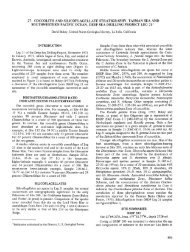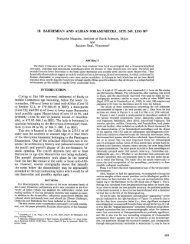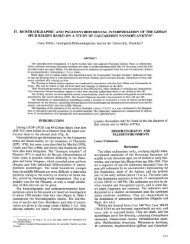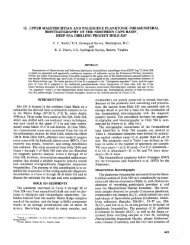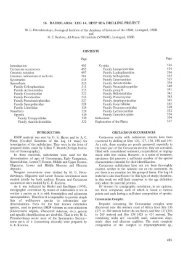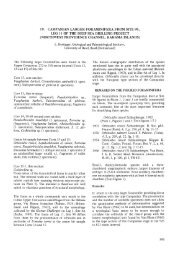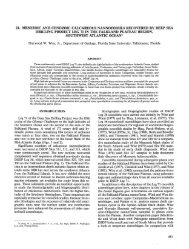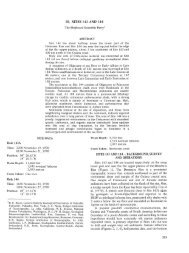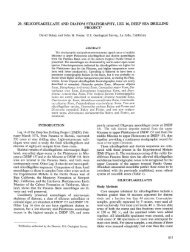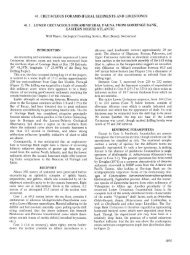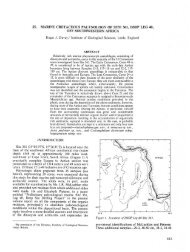17. Planktonic Foraminifera from the Upper Cretaceous of Site 98 ...
17. Planktonic Foraminifera from the Upper Cretaceous of Site 98 ...
17. Planktonic Foraminifera from the Upper Cretaceous of Site 98 ...
You also want an ePaper? Increase the reach of your titles
YUMPU automatically turns print PDFs into web optimized ePapers that Google loves.
leupoldi (at <strong>the</strong> top <strong>of</strong> <strong>the</strong> Campanian). Globotruncana<br />
falsostuarti is strictly biconvex, whereas G. leupoldi is<br />
somewhat dissymmetrical.<br />
Globotruncana leupoldi Bolli<br />
(Plate 2, Figure 1 a-b)<br />
1945 Globotruncana leupoldi Bolli, p. 235,1am. 17<br />
(holotype).<br />
1967 Globotruncana stephansoni Pessagno, plate 69,<br />
fig. 1-7; plate 96, fig. 5-6.<br />
1968 Globotruncana leupoldi Bolli, Longoria, lam. 1,<br />
fig. 4-6; lam. 9, fig. 1-4; lam. 19, fig. 2.<br />
This species is <strong>of</strong>ten confused with Globotruncana<br />
fornicata, G, area, and G. falsostuarti, because its<br />
holotype has been designated in a thin section.<br />
Globotruncana leupoldi has <strong>the</strong> same outline as G.<br />
fornicata, but <strong>the</strong> youngest chamber is always singlekeeled.<br />
The spiral surface <strong>of</strong> <strong>the</strong> chambers is always flat<br />
and never flexuous. Globotruncana leupoldi differs<br />
<strong>from</strong> G. area by its narrower inter-rim area. The two<br />
keels, which may be distinctly separated or become<br />
almost fused, form a sinuous line as in Globotruncana<br />
falsostuarti. The umbilical rim is always retracted<br />
below <strong>the</strong> spiral rim level and is always distinctly<br />
weaker; in places, it may be only faintly indicated.<br />
Globotruncana ventricosa White<br />
(Plate 2, Figure 3 a-c)<br />
1928 Globotruncana canaliculata var. ventricosa<br />
White, p. 284, pi. 38, fig. 5 a-c.<br />
This rare but characteristic species is here restricted to<br />
<strong>the</strong> late Campanian.<br />
Globotruncana stuartiformis Dalbiez<br />
(Text-figure 3b; Plate 1, Figure 2 a-c)<br />
1955 Globotruncana (Globotruncana) elevata stuartiformis<br />
Dalbiez, p. 171, text-fig. 10 a-c.<br />
1967 Globotruncana stuartiformis Dalbiez. Pessagno,<br />
pp. 357-59, et pi. 92, fig. 1-3.<br />
1970 Globotruncana elevata (Brotzen), Kuhry, pi. 1,<br />
fig. 4-9.<br />
Reference is made to <strong>the</strong> discussion <strong>of</strong> this species in<br />
<strong>the</strong> paragraph dealing with Globotruncana elevata. in<br />
Globotruncana stuartiformis <strong>the</strong> chambers are typically<br />
triangular on <strong>the</strong> spiral side, whereas <strong>the</strong>y are petaloid<br />
in G. stuarti.<br />
Globotruncana subspinosa Pessagno<br />
(Plate 1, Figures 3,4 a-c)<br />
1960 Globotruncana (Globotruncana) subspinosa<br />
Pessagno, pp. 101-102, pi. 1, figs. 1-9.<br />
Globotruncana subspinosa, a species introduced by<br />
Pessagno in 1960, was placed by <strong>the</strong> same author in<br />
1967 in synonymy with G. elevata. However, <strong>the</strong> very<br />
typical shape <strong>of</strong> <strong>the</strong> chambers on <strong>the</strong> spiral face in<br />
Globotruncana subspinosa and <strong>the</strong> fact that <strong>the</strong>se<br />
forms appear later than G. elevata justify considering<br />
G. subspinosa as a morphologically well individualized<br />
and stratigraphically useful species (see also discussion<br />
<strong>of</strong> G. elevata).<br />
REFERENCES<br />
Dalbiez, F., 1955. The genus Globotruncana in Tunisia.<br />
Micropaleontology. 1, (2), 161, text-figs. 1-10,<br />
charts 1-2.<br />
Hinte van, J. E., 1963. Zur Stratigraphic und Mikropalàontologie<br />
der Oberkreide und des Eozàns des<br />
Krappfeldes (Kàrnten). Austria, Geol. Bundesanst.,<br />
Jahrb., Sonderbd. 8, 1, pis. 1-22, text-figs. 1-15.<br />
Hinte van, J. E., 1965. The type Campanian and its<br />
planktonic foraminifera. /. K. Nederl. Akad.<br />
Wetensch., Proc. ser. B. 68, (1), 8, pis. 1-3, text-figs.<br />
1-9.<br />
Kuhry, B., 1970. Some observations on <strong>the</strong> type<br />
material <strong>of</strong> Globotruncana elevata (Brotzen) and<br />
Globotruncana concavata (Brotzen). Rev. Espan.<br />
Micr. II (3), 291, pi. 1-2, text-figs. 1-6.<br />
Longoria Trevino, J., 1968. Estudio en sección delgada<br />
de algunas especies del genero Globotruncana Cushman<br />
del Santoniano-Maestrichtiano del este de<br />
Mexico. Bol. Asoc. Mexican Geol. Petrol., XX,<br />
(3-12), 41, p. 1-19.<br />
Pessagno, E. A. jr., 1960. Stratigraphy and micropaleontology<br />
<strong>of</strong> <strong>the</strong> <strong>Cretaceous</strong> and lower Tertiary <strong>of</strong><br />
Puerto Rico. Micropaleontology. 6, (1), 87, pis. 1-5,<br />
text-figs. 1-2, charts 1-3.<br />
Pessagno, E. A. jr., 1962. The <strong>Upper</strong> <strong>Cretaceous</strong><br />
stratigraphy and micropaleontology <strong>of</strong> <strong>the</strong> Ponce-<br />
Coamo area, south-central Puerto Rico. Micropaleontology.<br />
8, (3), 349, pis. 1-6.<br />
Pessagno, E. A. jr., 1967. <strong>Upper</strong> <strong>Cretaceous</strong> planktonic<br />
foraminifera <strong>from</strong> <strong>the</strong> Western Gulf Coastal Plain.<br />
Paleont. Am. V, (37) 1, text-figs. 1-63, pis. 48-101.<br />
Sigal, J., 1952. Apercu stratigraphique sur la micropaléontologie<br />
du Crétacé. XIX Congr. Geol. Intern.<br />
Monographies régionales, sér. 1, n. 26, 1, figs. 1-46.<br />
555



